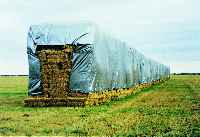| |
Beneficial Management Practices: Environmental Manual for Crop Producers in Alberta - Grain and Hay Storage | |
| |
|
|
| |
|
|
| | Grain storage | Hay storage
Grain, hay and silage need to be properly stored to protect the environment and to maintain crop quality. Leak-proof covers are essential for grain and silage and are preferred for hay. Storage should not be in a location where water runs or ponds. Storage structures need to be secure and stable. It is advisable to consult an engineer on the location, design and construction of large storage structures.
- For information on the design of crop storage facilities, go to the Canada Plan Service publications on Grain, Forage and Feed Structures.
Grain Storage
- Use water-proof and rodent-proof storage to prevent rotting and/or fecal contamination of the grain. Check the storage area regularly for holes or cracks and seal them.
- After use, clean out the leftover material from bins, and bury the material or take it to a landfill. Check for signs of insects and rodents in the bins.
- For more information, see Management of Cereal Grain in Storage (ARD) and Storage of Canola (AAFRD).
Hay Storage
- Cover bales with tarps to reduce spoilage, nutrient leaching and dry matter losses.
- Store bales on well drained areas.
- To protect hay stored outdoors from deer and elk, use electric fencing or provide alternative food sources for the animals (see box).
- To reduce fire hazard, store hay away from buildings, shelterbelts and power lines.

Cover bales, with tarps to reduce spoilage, nutrient leaching and dry matter losses.
Courtesy of AgTech Centre - ARD
Minimizing damage by deer and elk to stored feed
- Stack and wrap round bales at least two tiers high and keep edges as straight as possible to prevent deer and elk from climbing the stacks.
- Use appropriate fencing to protect stored feed from deer and elk.
- Clean up spilled grain, loose hay and other feed.
- Do not allow wildlife to linger and lose their fear of humans because they will attract others.
- Keep wildlife away from yards. Scarecrows wearing clothes with human scent and radios may be enough to keep them away if they have not become conditioned to humans or dependent on the food source.
- Contact your local Alberta Fish and Wildlife office for information on stack protection, scaring devices, repellents, fencing and other prevention programs.
Source: North American Waterfowl Management Plan, Alberta Prairie Care. 2001. Wildlife Damage Compensation and Prevention. Publication No. NWMP_007.
Back to Chapter 5 - Post-Harvest Crop Storage |
|
| |
|
|
| |
For more information about the content of this document, contact Roger Bryan.
This document is maintained by Jennifer Rutter.
This information published to the web on November 1, 2004.
Last Reviewed/Revised on October 30, 2017.
|
|